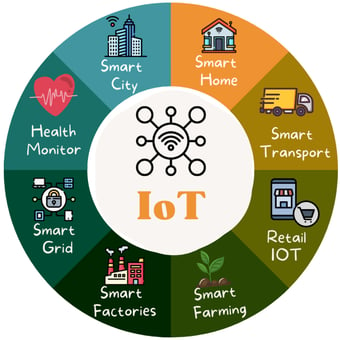Smart Manufacturing: How IoT is Transforming Industrial Machinery
The Internet of Things (IoT) is revolutionizing the industrial landscape, particularly in the realm of machinery. By integrating smart sensors and advanced connectivity, IoT enables real-time monitoring, predictive maintenance, and data-driven decision-making. These innovations lead to significant improvements in operational efficiency, reduced downtime, and enhanced productivity. In this blog, we explore how IoT is reshaping industrial machinery, offering insights into its benefits and real-world applications. Discover the future of smart manufacturing and how it's driving a new era of industrial excellence.
Kunal Rajendra Mulik
6/13/20243 min read


The Internet of Things (IoT) is revolutionizing the industrial landscape, particularly in the realm of machinery. By integrating smart sensors and advanced connectivity, IoT enables real-time monitoring, predictive maintenance, and data-driven decision-making. These innovations lead to significant improvements in operational efficiency, reduced downtime, and enhanced productivity. In this blog, we explore how IoT is reshaping industrial machinery, offering insights into its benefits and real-world applications. Discover the future of smart manufacturing and how it's driving a new era of industrial excellence.
Introduction to Smart Manufacturing
Smart Manufacturing is the use of advanced technologies such as IoT, Artificial Intelligence (AI), Virtual Reality (VR), and Augmented Reality (AR) to enhance the production processes. This approach focuses on creating a connected ecosystem where machines, systems, and humans work together seamlessly to improve efficiency and productivity.
The Role of IoT in Industrial Machinery:
IoT has a transformative effect on industrial machinery by enabling machines to communicate, collect data, and make decisions based on that data. This connectivity results in several key benefits:
1. Real-Time Monitoring
One of the most significant advantages of IoT in industrial machinery is real-time monitoring. Smart sensors embedded in machines continuously collect data on various parameters such as temperature, pressure, and vibration. This data is then transmitted to a central system where it is analyzed to ensure that the machinery is operating within optimal conditions.
2. Predictive Maintenance
Traditional maintenance strategies often involve routine checks and reactive repairs, which can lead to unexpected downtime and high costs. IoT enables predictive maintenance by using data analytics to predict when a machine is likely to fail. This allows maintenance to be performed just in time, reducing unnecessary downtime and extending the life of the machinery.
3. Data-Driven Decision Making
IoT provides a wealth of data that can be used to make informed decisions. By analyzing data from various machines and processes, manufacturers can identify inefficiencies, optimize operations, and improve product quality. Data-driven decision-making leads to more strategic and effective management of industrial machinery.
4. Enhanced Connectivity and Collaboration
IoT facilitates enhanced connectivity between machines, systems, and humans. This interconnected environment enables better collaboration and coordination, leading to more streamlined operations. For instance, data from IoT devices can be integrated with AI algorithms to optimize production schedules or with VR and AR technologies for training and troubleshooting.
Applications of IoT in Special Purpose and Customized Machinery
Special purpose and customized machinery are designed for specific tasks and tailored to meet unique production requirements. IoT plays a crucial role in these types of machinery by providing the following benefits:
1. Flexibility and Adaptability
IoT enables special-purpose and customized machinery to be more flexible and adaptable. For instance, sensors can detect changes in production requirements and adjust machine settings accordingly. This adaptability is particularly valuable in industries where production needs can change rapidly.
2. Improved Quality Control
By continuously monitoring production parameters, IoT ensures that customized machinery operates within specified tolerances. This real-time quality control helps in maintaining high standards and reducing defects.
3. Energy Efficiency
IoT helps in optimizing energy consumption by monitoring and controlling the power usage of machines. This not only reduces operational costs but also contributes to sustainability efforts.
The Integration of AI, VR, and AR in Industrial Machinery
IoT is not the only technology transforming industrial machinery. The integration of AI, VR, and AR further enhances the capabilities of smart manufacturing.
1. Artificial Intelligence (AI)
AI algorithms analyze the vast amounts of data collected by IoT devices to provide insights and recommendations. For instance, AI can optimize production schedules, predict equipment failures, and even suggest improvements in design and process.
2. Virtual Reality (VR)
VR is used for training operators and maintenance personnel. By creating a virtual environment that simulates real-world conditions, VR helps in developing skills without the risks associated with on-the-job training.
3. Augmented Reality (AR)
AR overlays digital information onto the physical world, providing real-time guidance and information to operators. For example, AR can be used to guide maintenance personnel through complex repairs by overlaying step-by-step instructions onto the machinery.
Future Trends in Smart Manufacturing
The future of smart manufacturing looks promising with continuous advancements in technology. Here are some trends to watch:
1. Increased Use of Edge Computing
Edge computing involves processing data closer to the source rather than relying on centralized cloud servers. This reduces latency and allows for faster decision-making, which is critical in industrial settings.
2. Blockchain for Enhanced Security
Blockchain technology can be used to enhance the security of IoT devices and data. By providing a secure and transparent way to record transactions and data, blockchain helps in preventing unauthorized access and ensuring data integrity.
3. 5G Connectivity
The rollout of 5G networks will provide faster and more reliable connectivity for IoT devices. This will enable even more advanced applications and improve the overall efficiency of smart manufacturing.
Conclusion
The integration of IoT in industrial machinery is driving a new era of smart manufacturing. By enabling real-time monitoring, predictive maintenance, and data-driven decision-making, IoT is significantly improving efficiency, productivity, and operational excellence. Coupled with AI, VR, and AR, the potential for innovation in special-purpose and customized machinery is immense. As technology continues to evolve, the future of smart manufacturing promises to be more connected, efficient, and intelligent than ever before.


Quality
Manufacturing top-notch food processing, industrial, agricultural machines.
Innovation
Efficiency
+91 9975189971 +91 8329053381
© 2024. All rights reserved.
